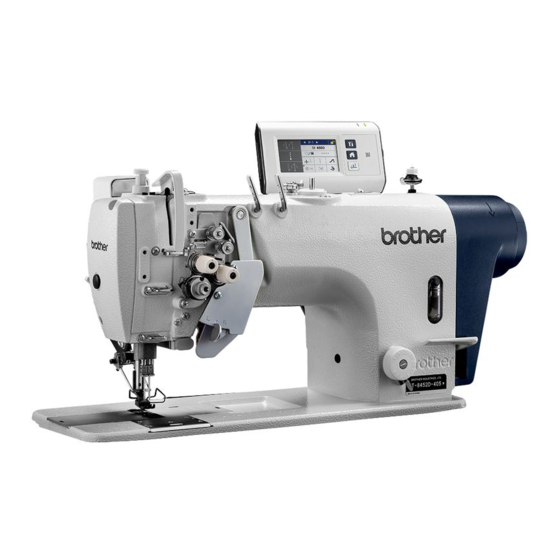
Summarization of Contents
Installation Guide
Pre-installation Checklist
Essential safety and setup guidelines before installing the sewing machine.
Machine Setup and Handling
Guidance on choosing a location, carrying, tilting, and returning the machine head.
Table Prep and Component Installation
Details for table preparation and installing main machine components like control box and oil pan.
Knee Lifter and Lubrication
Steps for adjusting the knee lifter and performing initial lubrication.
Connecting Electrical Cords
Instructions for safely connecting power and control cables to the machine.
Power On and Initial Testing
Procedures for turning on the machine and performing initial test sewing.
Treadle Operation Adjustment
How to adjust the sensitivity and stroke of the treadle for optimal control.
Preparation for Sewing
Needle and Bobbin Handling
Proper methods for inserting needles, removing, winding, and installing bobbins.
Upper Threading Procedures
Step-by-step guide for threading the upper thread through machine parts.
Stitch Length and Special Functions
Adjusting stitch length and using knee lifter and thread wiper features.
Needle Bar Control for Twin Needles
How to stop individual needle bars for twin-needle sewing operations.
Stitch Count Quick Reference
A chart relating sewing angle to the number of stitches for corner stitching.
Operation Panel Basics
Operation Panel Overview
Explanation of the panel layout, keys, display, and home screen types.
Home Screen Navigation
How to navigate between detailed, basic, and quick home screens.
Detailed Home Screen Functions
In-depth explanation of all keys and icons on the detailed home screen.
Quick Home Screen Functions
Overview of controls available on the quick home screen.
Icon Types and Menu Navigation
Classification of display icons and how to access the menu.
Program Setting Methods
How to set up and manage sewing programs, including backtack and individual functions.
Using Counters
How to use the production and lower thread counters for monitoring.
Home Screen Mode Selection
Customizing the display by choosing between different home screen modes.
Needle Stop Position Adjustment
Fine-tuning the needle's resting position after sewing operations.
Operation Panel Advanced Operations
Program Step Management
Adding, deleting, and editing individual steps within sewing programs.
Multi-Step Program Parameters
Adjusting main sewing and backtack parameters for specific steps.
Program Management and Initialization
Copying programs and resetting selected programs to default settings.
Working Pace and Memory Switches
Configuring working pace and standard memory switch values.
Memory Switch List and Device Settings
Detailed list of memory switch functions and standard device configurations.
Hand Switch Customization
Assigning functions to the hand switch for control during sewing.
USB Media Data Transfer
Reading and writing program and setting data using USB media.
Initialization Procedures
Restoring machine settings by initializing stored data.
Sewing Operations
Pre-Sewing Safety Precautions
Essential safety guidelines to follow before starting any sewing operation.
Basic Sewing and Backtacking
Step-by-step guide to starting sewing, threading, and performing backtacking.
Special Sewing Techniques
Instructions for sewing condensed stitches and setting them up.
Adjusting Stitch Tension and Pressure
Thread Tension Adjustment
How to adjust upper and lower thread tensions for even stitches.
Presser Foot Pressure Settings
Adjusting the pressure applied by the presser foot for different materials.
Presser Foot Floating Amount
Fine-tuning the presser foot's lifting height for specific sewing needs.
Upper Thread Post-Trimming Management
Adjusting the upper thread length after automatic thread trimming.
Thread Take-Up Amount Adjustment
Modifying the thread take-up amount for optimal thread delivery.
Daily Cleaning and Maintenance
Cleaning Precautions and Basics
Essential safety notes and daily cleaning steps for machine upkeep.
Needle/Thread Checks and Oil Draining
Inspecting needle/thread condition and procedures for draining excess oil.
Lubricating Oil Cover and Grease Application
Routine lubrication of the oil cover and applying grease when prompted.
Resetting Grease Notification
Procedure to clear the grease-up warning and reset the notification timer.
Standard Machine Adjustments
General Adjustment Precautions
Important safety and handling guidelines before performing adjustments.
Safety Switch Adjustment
How to adjust the safety switch position for proper operation.
Thread Take-Up and Tension Adjustments
Adjusting thread take-up spring heights and thread tension spring settings.
Rotary Hook Clearance Adjustments
Setting clearances for the rotary hook with the needle plate and opener.
Presser Foot Height and Timing
Setting presser foot height and adjusting needle/rotary hook timing.
Feed Dog Adjustments
Installing and adjusting feed dog position, height, and angle.
Rotary Hook Lubrication
Checking and adjusting the oil supply to the rotary hook.
Troubleshooting Guide
Sewing Issues
Common problems during sewing, their causes, and solutions.
Error Code Reference
List of error codes, causes, and remedies for panel display issues.
Switch and Connection Errors
Troubleshooting errors related to switches, connections, and panel communication.
Motor and Power Supply Errors
Diagnosing issues with the sewing machine motor, power supply, and encoder.
Software and PC Board Errors
Resolving errors related to software, firmware, and PC board malfunctions.
Version Updating Errors
Troubleshooting issues that may occur during software or firmware updates.










Need help?
Do you have a question about the T-8422D and is the answer not in the manual?
Questions and answers